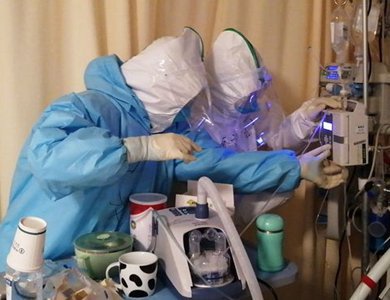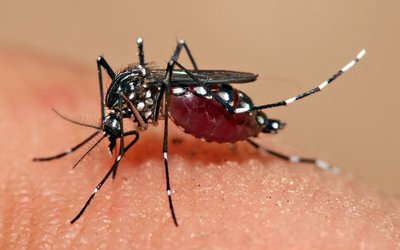
The World Health Organization (WHO) has warned the window of opportunity to stem the deadly coronavirus epidemic was "narrowing" amid concern about a surge in cases with no clear link to China, including in a range of countries in the Middle East.
WHO advise the consumption of raw or undercooked animal products should be avoided. Raw meat, raw milk or raw animal organs should be handled with care to avoid cross-contamination with uncooked foods.
SARS-CoV and MERS-CoV are susceptible to the most common cleaning and disinfection protocols and there is no indication so far that SARS-Cov-2 behaves differently. Additional recommendations and materials on food
The new COVID-19 is caused by the virus SARS-CoV-2. The most likely ecological reservoirs for SARS-CoV-2 are bats, but it is believed that the virus jumped the species barrier to humans from another intermediate animal host. This intermediate animal host could be a domestic food animal, a wild animal, or a domesticated wild animal which has not yet been identified.
WHO continues to collaborate with experts, Member States and other partners to identify gaps and research priorities for the control of COVID-19, and provide advice to countries and individuals on prevention measures. National food safety authorities have been following this event with the International Food Safety Authorities Network (INFOSAN) Secretariat to seek more information on the potential for persistence of the virus on foods traded internationally and the potential role of food in the transmission of the virus.
Experiences from previous outbreaks of related coronaviruses, such as the Severe Acute Respiratory Syndrome coronavirus (SARS-CoV) and Middle East respiratory syndrome coronavirus (MERS-CoV) show that transmission through food consumption did not occur. To date, there have not been any reports of transmission of SARS-CoV-2 virus through food. However, concerns were expressed about the potential for these viruses to persist on raw foods of animal origin. Currently, there are investigations conducted to evaluate the viability and survival time of SARS-CoV-2.
In general, coronaviruses are very stable in a frozen state according to studies of other coronaviruses, which have shown survival for up to two years at -20°C. Studies conducted on SARS-CoV ad MERS-CoV indicate that these viruses can persist on different surfaces for up to a few days depending on a combination of parameters such as temperature, humidity and light.
For example, at refrigeration temperature (4°C), MERS-CoV can remain viable for up to 72 hours. Current evidence on other coronavirus strains shows that while coronaviruses appear to be stable at low and freezing temperatures for a certain period, food hygiene and good food safety practices can prevent their transmission through food. Specifically, coronaviruses are thermolabile, which means that they are susceptible to normal cooking temperatures (70°C).
Lebanon and Israel confirmed their first cases on Friday, while Iran's health ministry reported two more deaths among 13 new cases of the infection, known as COVID-19. That brings the toll in Iran to four and the number of infections to 18.
Italy, meanwhile, reported its first death from the coronavirus as authorities moved to close schools, bars and other public spaces in 10 northern towns.
In mainland China, the death toll stood at 2,345 while the number of infections reached 76,288.
Mainland China had 397 new confirmed cases of coronavirus infections as of the end of February 21, the country's National Health Commission said on Saturday, down from 889 cases a day earlier.
That brings the total accumulated number of confirmed cases in mainland China so far to 76,288.
The death toll from the outbreak in mainland China had reached 2,345 as of the end of February 21.
The central province of Hubei, the epicentre of the outbreak, reported 109 new deaths, while in the provincial capital of Wuhan, 90 people died.
Wuhan woman with no symptoms infects five relatives with coronavirus
A 20-year-old Chinese woman from Wuhan, the epicenter of the coronavirus outbreak, traveled 675 km (400 miles) north to Anyang where she infected five relatives, without ever showing signs of infection, Chinese scientists reported, offering new evidence that the virus can be spread asymptomatically.
According to the report by Dr. Meiyun Wang of the People's Hospital of Zhengzhou University and colleagues, doctors isolated the woman and tested her for the virus after her relatives started getting sick.
Initially, the young woman tested negative for the virus, but a follow-up test was positive.
All five of her relatives developed COVID-19 pneumonia, but as of February 11, the young woman still had not developed any symptoms, her chest CT remained normal and she had no fever, stomach or respiratory symptoms, such as cough or sore throat.
The case study was published in the Journal of the American Medical Association.
South Korea Reports 142 More Novel Coronavirus Cases
South Korea on Saturday reported 142 more confirmed cases of the novel coronavirus (COVID-19), according to Yonhap News Agency.
This brings the total number of infections in the country to 346.
On Friday, South Korea declared the southeastern city of Daegu and its adjacent county Cheongdo as "special care zones" after a coronavirus cluster was reported there in recent days.
Two South Korean COVID-19 patients died during the week from pneumonia.
Wuhan To Build 19 More makeshift hospitals to contain epidemic
Wuhan, the epicenter of the new coronavirus outbreak, plans to build another 19 makeshift hospitals to receive more infected patients, local authorities said Friday.
Upon completion, all makeshift hospitals in Wuhan are expected to offer 30,000 beds by February 25, said Hu Yabo, deputy mayor of Wuhan at a press briefing.
To date, Wuhan has converted 13 existing venues into temporary hospitals, with a total of 13,348 beds, and about 9,313 beds have been put into use to treat patients with mild symptoms, said Hu.
To improve their medical treatment capability, every makeshift hospital will be supplied with CT scanners and other medical equipment including ECG monitors (a device used to analyze patients' heart rhythm and other cardiac issues), Hu added.
Meanwhile, among these makeshift hospitals is one converted from a factory. It will boast the largest number of beds among the city's makeshift hospitals.
The construction of Rihai temporary hospital with 3,690 beds was completed and passed checks on Thursday, according to one of its constructors, China Communications Construction Company Limited (CCCC) Second Harbour Engineering Company.
The hospital was converted from four empty plants, covering a total area of 54,000 square meters.
Liu Yiquan, the project chief with the company, said ventilation and air purification systems were added in the hospital to ensure air quality, which he said posed a major challenge for isolation wards of a large size. The wastewater produced by the hospital will also be disinfected before discharge, Liu said.
Apart from air-conditioning, shower rooms and mobile toilets, the hospital is also complete with leisure areas, including libraries, movie areas and snack bars for patients to read and relax.
Wuhan's temporary hospitals, converted from gyms and convention and exhibition centers, have been set up as the city faces a shortage of beds amid the coronavirus epidemic. The hospitals are meant mainly to treat patients with mild symptoms.
About 72 medical teams from other regions of China have been dispatched to these temporary hospitals to aid local colleagues to treat patients and contain the virus spread. A total of 32,572 medical personnel from across China have been sent to save lives here.
The total number of confirmed cases in hard-hit Wuhan was 49,063 as of Friday.
Across the Chinese mainland, more than 75,000 people have been infected and 2,236 have died from the virus.
Credit various news agencies
- Nepal-UK Tech Forum Held
- Jul 06, 2025
- Hari Sayani or Devshayani Ekadashi 2025: Day Of Tulsi Plantation
- Jul 06, 2025
- Siddhababa Tunnel Makes A Major Milestone
- Jul 06, 2025
- Weather Forecast: Generally Cloudy Across The Country With Heavy Rain At One Or Two Places Gandaki, Bagmati and Koshi Provinces
- Jul 06, 2025
- India’s External Affairs Ministry’s Senior Officials Says Indo-Nepal relations are ever expanding
- Jul 05, 2025














